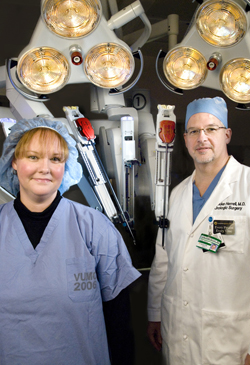
S. Duke Herrell, M.D., right, used a new form of robotic laparoscopic kidney surgery to operate on Bannar Rawlings, left. (photo by Susan Urmy)
Robot technology helps power new kidney surgery
Bannar Rawlings is forever grateful to the Vanderbilt radiologist who saw something suspicious on her kidney.
Rawlings was undergoing an MRI for a back operation when the radiologist spotted a cancerous lesion. The 30-year-old assistant to the chair of Neurosurgery believes she is equally lucky to be at a medical center that offered her a new form of robotic laparoscopic surgery.
“After having the back surgeries I wanted my downtime to be as short as possible, and I wanted the pain to be minimal,” Rawlings said.
Rawlings was one of the first Vanderbilt patients to undergo robotic laparoscopic kidney cancer surgery, performed by S. Duke Herrell, M.D., associate professor of Urologic Surgery and director of Minimally Invasive Urologic Surgery and Robotics. Herrell has performed more than 1,000 laparoscopic kidney surgeries and partial nephrectomies, making him one of the most experienced laparoscopic kidney surgeons in the country.
Herrell was recruited to VMC to develop advanced laparoscopic and minimally invasive cancer surgeries and to help develop the robotic prostate cancer program. He has now translated those skills to kidney cases.
“Twenty years ago there was one operation if there was something wrong with your kidney, and that was to make a big flank incision through your side, at least six to eight inches, and remove your entire kidney,” Herrell explained. “That was done whether your tumor was the size of a dime or a football. Over the past eight years, I have been using laparoscopic surgery for smaller tumors, putting the kidney back together and getting good cancer results.”
Robots, like the da Vinci Surgical System, may offer surgeons even more control. The robot has a wrist, which normal laparoscopic tools don't have. This wrist action allows the surgeon to maneuver needles and sutures more easily.
“Reconstructing kidneys when you've taken them apart can be very challenging, and you're doing it in a pressured environment because you have the blood flow to the kidney stopped,” Herrell said. “The robot visualization system is 3-dimensional, while laparoscopic surgery is not. With the robot you control the camera and the robot's other arms for suturing and retraction.”
Herrell, however, cautions that the robot is no substitute for experience in minimally invasive kidney surgery.
Removing the cancerous tumor surgically is crucial because kidney cancer often doesn't respond to standard chemotherapy or radiation. Now the challenge is to perform the surgery in a minimally invasive way so the patient maintains good renal function.
“We know we have a surgery that's going to benefit the patient, get rid of the cancer, and now we can make it less morbid for the patient,” said Herrell.
Rawlings was able to go home after just two days in the hospital. She spent several weeks at home recuperating and believes it would have been far worse with traditional kidney surgery.
“I know it's very new but it worked well for me,” she said. “They were able to minimize how much of the kidney they had to remove, minimize the pain, the amount of time I was in the hospital and the time I was out of work.”













